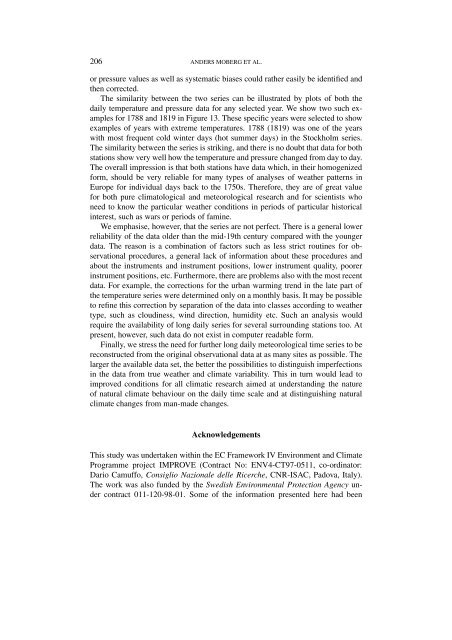DAILY AIR TEMPERATURE AND PRESSURE SERIES ... - BALTEX
DAILY AIR TEMPERATURE AND PRESSURE SERIES ... - BALTEX
DAILY AIR TEMPERATURE AND PRESSURE SERIES ... - BALTEX
You also want an ePaper? Increase the reach of your titles
YUMPU automatically turns print PDFs into web optimized ePapers that Google loves.
206 <strong>AND</strong>ERS MOBERG ET AL.<br />
or pressure values as well as systematic biases could rather easily be identified and<br />
then corrected.<br />
The similarity between the two series can be illustrated by plots of both the<br />
daily temperature and pressure data for any selected year. We show two such examples<br />
for 1788 and 1819 in Figure 13. These specific years were selected to show<br />
examples of years with extreme temperatures. 1788 (1819) was one of the years<br />
with most frequent cold winter days (hot summer days) in the Stockholm series.<br />
The similarity between the series is striking, and there is no doubt that data for both<br />
stations show very well how the temperature and pressure changed from day to day.<br />
The overall impression is that both stations have data which, in their homogenized<br />
form, should be very reliable for many types of analyses of weather patterns in<br />
Europe for individual days back to the 1750s. Therefore, they are of great value<br />
for both pure climatological and meteorological research and for scientists who<br />
need to know the particular weather conditions in periods of particular historical<br />
interest, such as wars or periods of famine.<br />
We emphasise, however, that the series are not perfect. There is a general lower<br />
reliability of the data older than the mid-19th century compared with the younger<br />
data. The reason is a combination of factors such as less strict routines for observational<br />
procedures, a general lack of information about these procedures and<br />
about the instruments and instrument positions, lower instrument quality, poorer<br />
instrument positions, etc. Furthermore, there are problems also with the most recent<br />
data. For example, the corrections for the urban warming trend in the late part of<br />
the temperature series were determined only on a monthly basis. It may be possible<br />
to refine this correction by separation of the data into classes according to weather<br />
type, such as cloudiness, wind direction, humidity etc. Such an analysis would<br />
require the availability of long daily series for several surrounding stations too. At<br />
present, however, such data do not exist in computer readable form.<br />
Finally, we stress the need for further long daily meteorological time series to be<br />
reconstructed from the original observational data at as many sites as possible. The<br />
larger the available data set, the better the possibilities to distinguish imperfections<br />
in the data from true weather and climate variability. This in turn would lead to<br />
improved conditions for all climatic research aimed at understanding the nature<br />
of natural climate behaviour on the daily time scale and at distinguishing natural<br />
climate changes from man-made changes.<br />
Acknowledgements<br />
This study was undertaken within the EC Framework IV Environment and Climate<br />
Programme project IMPROVE (Contract No: ENV4-CT97-0511, co-ordinator:<br />
Dario Camuffo, Consiglio Nazionale delle Ricerche, CNR-ISAC, Padova, Italy).<br />
The work was also funded by the Swedish Environmental Protection Agency under<br />
contract 011-120-98-01. Some of the information presented here had been













